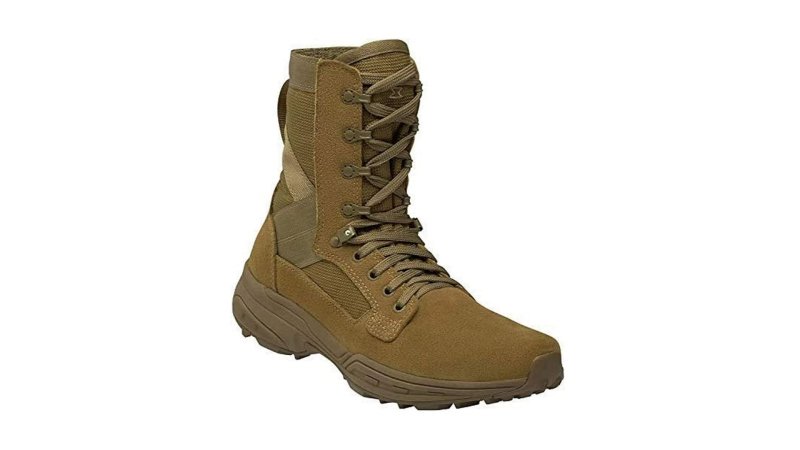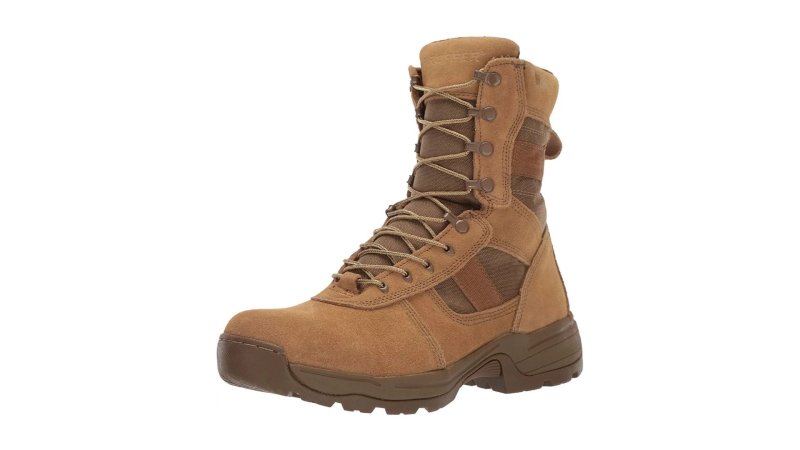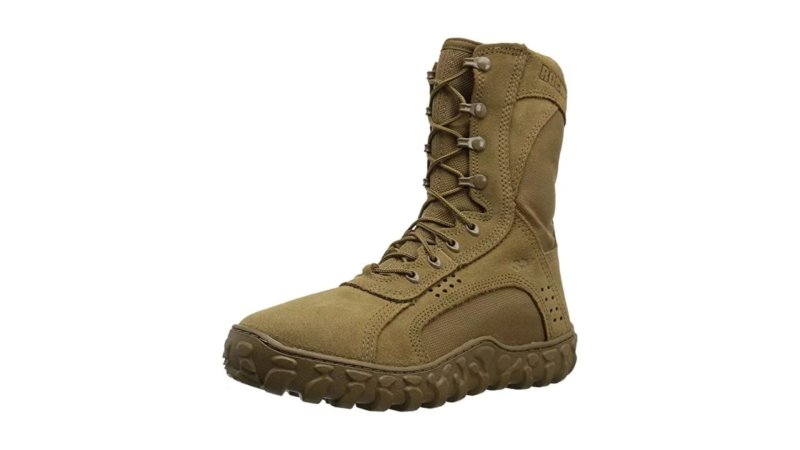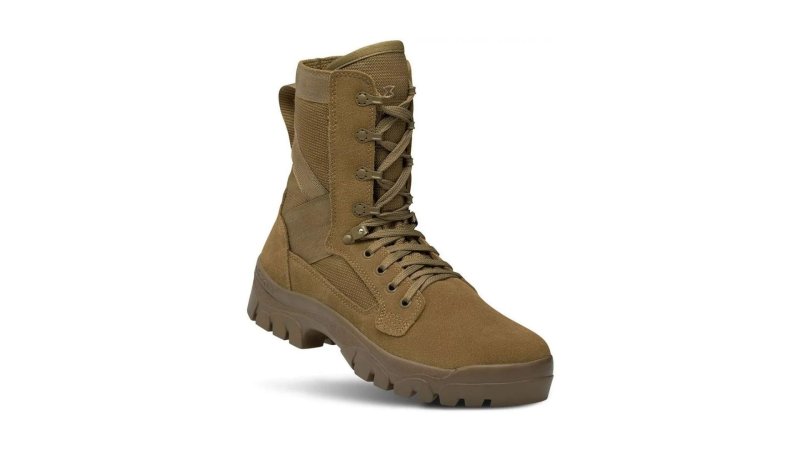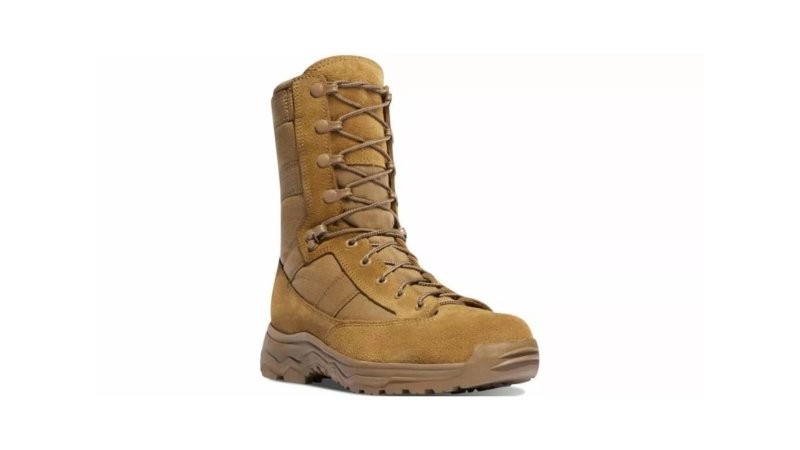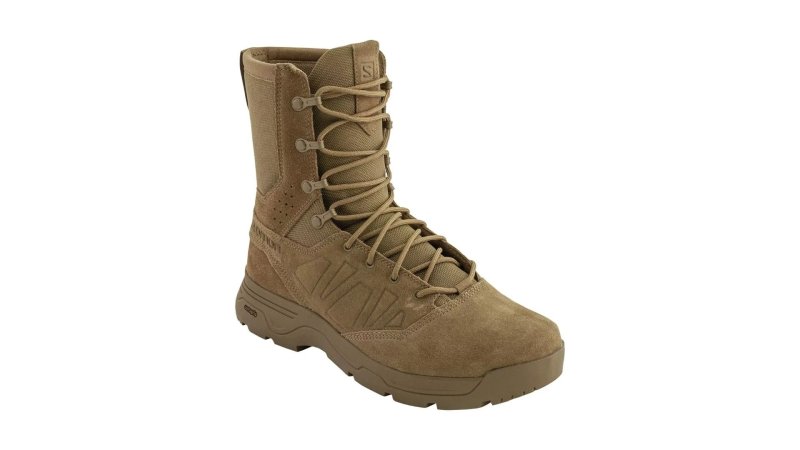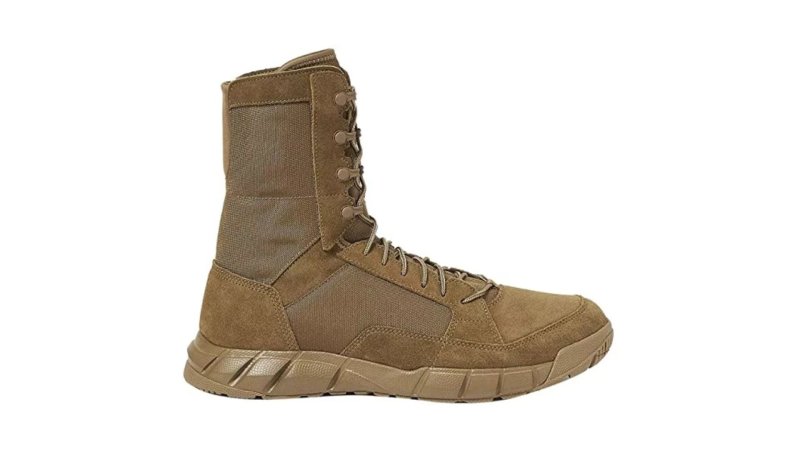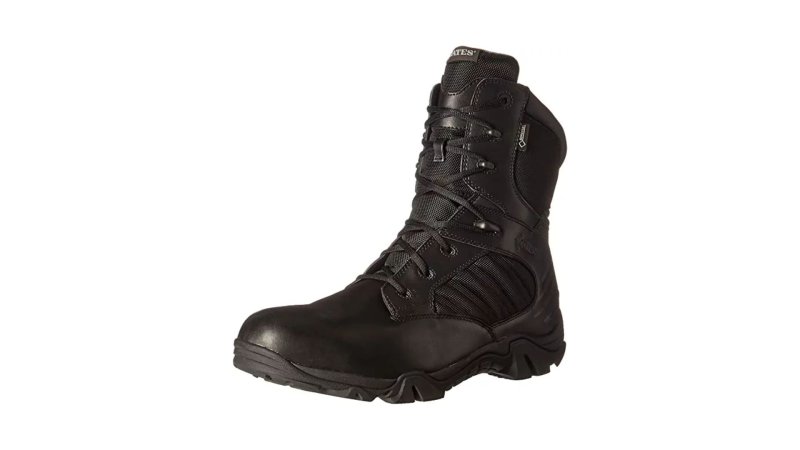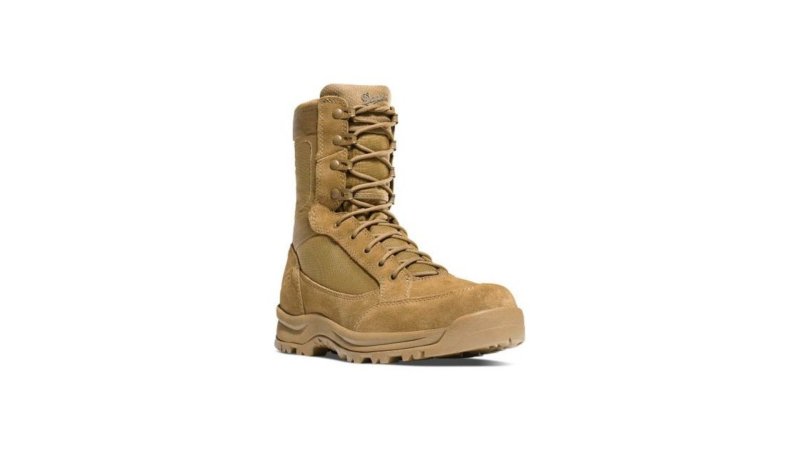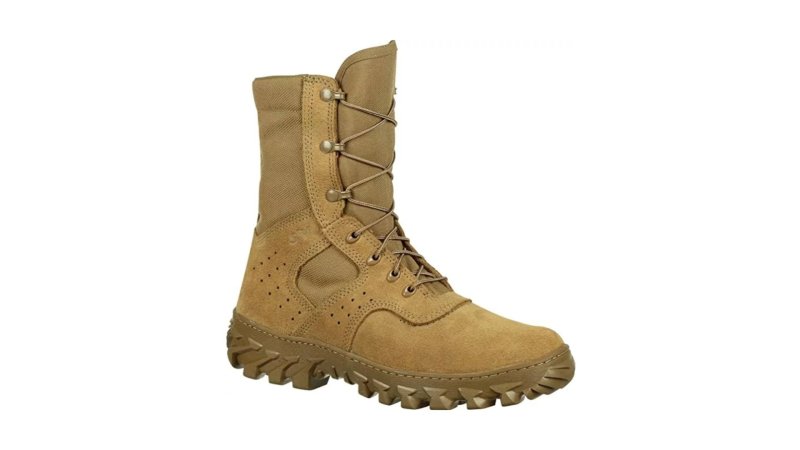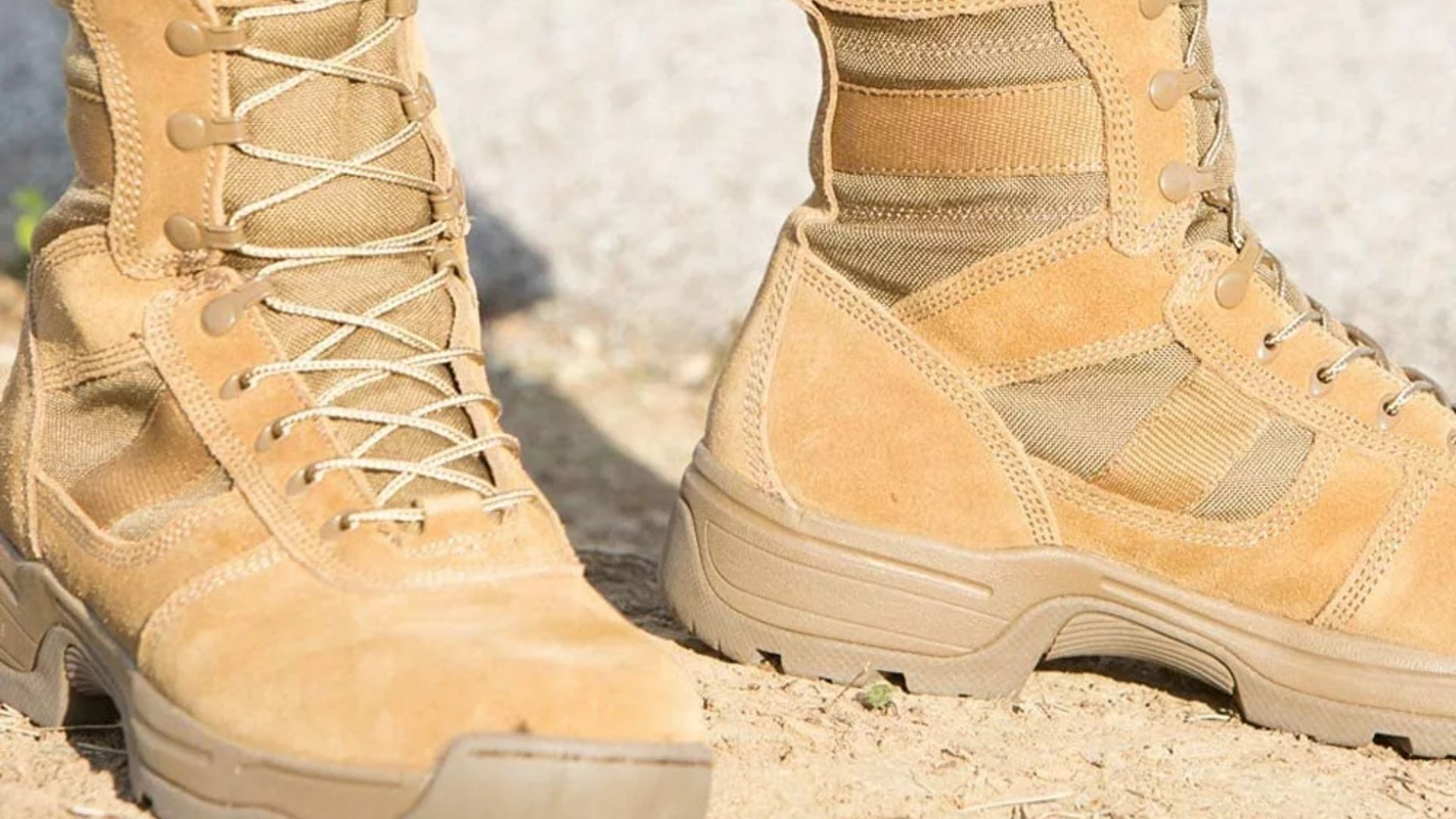

We may earn revenue from the products available on this page and participate in affiliate programs.
When operators hit the ground, they do so with their legs pumping, ready to achieve their objectives with speed and precision. An operator’s feet are one of his or her greatest assets, so the proper tactical boots can literally make the difference between life and death in the heat of the moment.
A solid pair of boots keeps you stable, mobile, and safe in a vast array of different environments, from urban terrain and scorching deserts to mountain passes and tangled forests. At high speeds, the right pair of tactical boots makes you a low-drag operator, resisting rocks, water, mud, and more, and laughing off abrasions and other abuse as if they were merely marshmallows. Most importantly, good tactical boots keep your feet comfortable and dry, even in the harshest of conditions, so you can skip the footbath at the end of the day.
Mission accomplished. Now, check out the boots that’ll be there every step of the way.
- Best Overall: Garmont T8 NFS
- Best Value: Propper Men’s Series 100
- Editor’s Choice: Rocky S2V Special Ops (RKC050)
- Best Army: Garmont T8 Bifida
- Best Marine Corps: Danner Reckoning Hot EGA
- Best Air Force: Salomon Forces Guardian
- Best Navy: Oakley SI Light Assault 2
- Best Coast Guard: Bates GX-8
- Best Mountain: Garmont T8 Extreme GTX
- Best Hot Weather: Danner Tanicus
- Best Jungle: Rocky S2V Enhanced Jungle Boot
Best Overall
Garmont T8 NFS
Pros
- Very comfortable
- Very lightweight
- Tough
- Breathable; dry very quickly
Cons
- Not as durable as heavy-duty boots
- Heel rubbing may occur during break-in period
- Slightly lower traction on smooth surfaces
Product Specs
- Construction material: Suede leather, 600D nylon, nylon webbing
- Branch compliance: Army, Air Force, Space Force
- Weight (per pair): 2.38 pounds
Best Value
Propper Men's Series 100
Pros
- Affordable
- Lightweight yet durable
- Comfortable yet supportive
- Waterproof version available
Cons
- Limited insole support
- Lacks high-quality laces
Product Specs
- Construction material: Flesh-out cattle hide, 1000D nylon
- Branch compliance: Army, Air Force, Space Force
- Weight (per pair): 2.84 pounds
Editor’s Choice
Rocky S2V Special Ops (RKC050)
Pros
- Good traction
- Durable
- Comfortable
- Meets most U.S. military uniform regulations
Cons
- Expensive
- Heavy
Product Specs
- Construction material: Flash and water-resistant leather
- Branch compliance: Army, Navy, Air Force, Space Force
- Weight (per pair): 4 pounds
Best Army
Garmont T8 Bifida
Pros
- Lightweight yet very durable
- Breathable
- Flexible yet supportive
- Available in regular and wide sizes
Cons
- Lacks padding
- Not ideal in cold environments
Product Specs
- Construction material: Suede leather, 600D nylon, nylon webbing
- Branch compliance: Army, Air Force, Space Force
- Weight (per pair): 2.91 pounds
Best Marine Corps
Danner Reckoning Hot EGA
Pros
- Comfortable
- Reasonably lightweight
- Non-EGA version complies with Army, Air Force, and Space Force regulations
Cons
- Expensive
- Not the most durable
- Glued sole
Product Specs
- Construction material: Suede leather, abrasion-resistant nylon
- Branch compliance: Marine Corps
- Weight (per pair): 3.32 pounds
Best Air Force
Salomon Forces Guardian
Pros
- Comfortable yet supportive
- Good traction
- Good protection
- Wide sizes and waterproof version available (Guardian CSWP)
Cons
- Warm
- Not very breathable; lacks drainage vents
- Thick soles can be cumbersome
Product Specs
- Construction material: Split-suede leather
- Branch compliance: Air Force, Space Force, Army
- Weight (per pair): 3 pounds
Best Navy
Oakley SI Light Assault 2
Pros
- Very lightweight
- Require little to no maintenance
- Handle wide temperature ranges well
- Available in coyote and black
Cons
- Not for shipboard use
- Lacks waterproofing
- Not ideal for extended field use
Product Specs
- Construction material: Leather and nylon
- Branch compliance: Navy, Army, Air Force, Space Force
- Weight (per pair): 1.75 pounds
Best Coast Guard
Bates GX-8
Pros
- Lightweight
- Comfortable
- Waterproof
- ASTM F2413-11-rated composite toe
Cons
- A little pricey
- Not insulated
- Occasional QC issues
Product Specs
- Construction material: Full grain leather, ballistic nylon
- Branch compliance: Coast Guard
- Weight (per pair): Under 3 pounds
Best Mountain
Garmont T8 Extreme GTX
Pros
- Insulated
- Waterproof
- Relatively lightweight yet very durable
- Available in regular and wide sizes
Cons
- May run a little narrow
- Not for warm climates
Product Specs
- Construction material: Suede leather, 600D nylon, nylon webbing
- Branch compliance: Army, Air Force, Space Force
- Weight (per pair): 3 pounds
Best Hot Weather
Danner Tanicus
Pros
- Lightweight
- Breathable
- Very comfortable
- Includes convenient lace storage pocket
Cons
- May pinch some during break-in period
- May run a little small, narrow
Product Specs
- Construction material: Full-grain rough-out leather, 1000D nylon
- Branch compliance: Army, Air Force, Space Force
- Weight (per pair): 2.44 pounds
Best Jungle
Rocky S2V Enhanced Jungle Boot
Pros
- Very lightweight
- Good traction
- Puncture-resistant
- Berry-compliant
Cons
- Expensive
- Lack of padding
- Limited ankle support
Product Specs
- Construction material: Flesh-out cattle hide, 1000D Cordura
- Branch compliance: Army, Air Force, Space Force
- Weight (per pair): 2 pounds
Why you should trust us
Here at Task & Purpose, we know boots. With decades of combined experience in the field and on the trails, we know what makes a good boot and what doesn’t. We’ve covered all different kinds of hiking boots, hunting boots, and combat boots, and we’ve done plenty of hands-on boot reviews. We understand that bad boots can cost lives both on duty and off, and we refuse to recommend anything less than the best.
As a gear reviewer and Rocky Mountain hiker, I personally have spent countless hours learning the ups and downs and ins and outs of outdoor and tactical footwear. Like the rest of our team, I am always looking for top-notch gear, and sometimes, that means tapping other experts for their advice. For this piece, I found the folks at 5.11 Tactical, Theusmarines.com, U.S. Army Aeromedical Research Lab, U.S. Navy Personnel Command, the USMC and USMC Training Command, and US Patriot Tactical to be particularly helpful. I also need to thank the U.S. Air Force, U.S. Coast Guard, and U.S. Space Force for their guidance as well.
Types of tactical boots
This may come as a surprise to some, but the market is littered with a number of different types of tactical boots, each with its pros and cons. Urban/garrison boots and field boots are the most common, although running boots and work boots also make plenty of appearances throughout the military.
Field boots
Field boots are the ideal tactical solution for rural and semi-rural settings with limited to no infrastructure. These tactical boots often include a number of unique features designed to handle unique environments. The most common types of field boots are jungle, mountain, and desert (i.e., hot-weather) boots.
With roots in the Vietnam era, jungle boots possess the abilities to drain and dry quickly, breathe easily, deny entrance to creepy crawlies, and bite into slippery terrain. Mountain boots leverage aggressive tread patterns for excellent traction and often feature waterproofing, insulation, or both. Desert boots feature a breathable construction, usually including dedicated cooling vents and sport-aggressive tread lugs, although slightly less so than their high-altitude brothers in arms.
Urban boots
Urban tactical boots provide wearers with a pavement-friendly option for operations both in and around buildings, on the street, and in dark alleys. These boots often are lightweight and bypass bigger tread lugs to minimize weight and drag on smooth surfaces, such as concrete, asphalt, or tile. These boots are more likely than most other tactical boots to incorporate an athletic shoe fit and feel, making them more comfortable than the more traditional field boot.
While designated as “urban,” these boots also can be solid choices for wet and industrial combat zones. Urban boots may include anti-slip and/or oil-resistant outsoles in order to increase traction in slick settings, making them an incredibly valuable asset for some warfighters.
Safety boots
Tactical safety boots often look similar, if not identical, to other tactical boots but include a number of unique components that more traditional boots lack. In addition to a relatively aggressive tread, these boots include an internal steel or composite toe cap for reliable protection against toe injuries when working around heavy materials or machinery. Other critical features may also include waterproofing, insulation, and oil-resistant or otherwise slip-resistant outsoles.
While these boots are most commonly found aboard U.S. Navy and Coast Guard ships and boats, members of other branches may find them valuable as well. Marines, soldiers, and airmen working around heavy machinery or in construction zones may also need to invest in a pair of tactical safety boots, especially in and near a war zone.
Speed boots
The U.S. military’s love affair with physical fitness is well-known, and recently, the Pentagon has developed a special affinity for “realistic” training sessions, like running in tactical boots. While this has plenty of practical applications in combat, the reality is that many U.S. servicemen and women spend the entirety of their military career without seeing an actual battlefield, let alone running on one, so having a dedicated pair of running boots can make your life a whole lot easier.
Speed boots (our term) are a fairly rare breed of boot. While seemingly identical to running boots, speed boots are the combat-ready equivalent. Running boots are designed for pounding the pavement, making them some of the lightest tactical boots around, but they tend not to hold up well in the field. Speed boots increase the toughness, durability, and traction of a running boot in order to combine the best of both worlds.
Key features of tactical boots
A good pair of tactical boots is packed full of practical features, and if you even care a little bit about your feet, it pays to know what these features are. All boots should be durable and comfortable while providing plenty of support. Considerations such as weight, tread pattern, side zippers, and protective toe caps are also worthy of your consideration. So, sit up and take notes.
Durability
More than anything else, tactical boots must be durable. A proper pair of boots must be ready to withstand the punishment dished out by a Marine Corps rifleman in Kunar. Boots that pop a seam the first time you squat to inspect the underside of a Humvee are not worth the money, hassle, and frustration they can cause, especially if an officer sees them.
When looking for durable boots, pay attention to how well a boot is built. Does it use high-quality, genuine leather? Is the nylon capable of handling long-term abuse? Are the weak points properly reinforced? Are the soles thick enough to handle the kind of duty that will come their way? If the answer to all of these questions is “yes,” then you’ve likely found a good boot.
Weight
Everyone knows that ounces equal pounds, and pounds equal pain. With the exception of running and jungle variants, tactical boots have a reputation for being quite heavy which can be absolutely punishing on long foot patrols. Finding a lightweight boot that can withstand the rigors of tactical operations is a gamechanger, but such boots can be quite a challenge to track down.
In the words of Ronald Reagan, “trust, but verify.” When shopping for a pair of lightweight boots, never fully trust the manufacturer’s claims about how much abuse a featherweight boot can take. If you want to reduce the misery of your next ruck march, do your own research, and if possible, weigh the boots yourself to see what you’re really getting yourself into.
Tread
Finding the proper tread for your intended application will do wonders for both your mental and physical health. While plenty of things can go sideways in a dynamic situation, the last thing you need is to find yourself slipping and tripping all over the battlefield.
Need something for mountain use? Grab a pair of mountain-friendly kicks with plenty of aggressive lugs. Need something for urban SWAT applications (or garrison duty)? Look for a pair of boots with tame lugs. Need to qualify for fast roping operations? Yep, there are boot treads for that, too. No matter what your intended application, the proper tread can make the difference between going full operator or falling flat on your face. The choice is yours.
Support
Firefights and other tactical situations change incredibly quickly, and the last thing you need is to roll an ankle when lead starts looking for a target. On the flip side, infantrymen the world over know and dread the drudgery and demands of ruck marches, but as much hatred as 60-plus pounds of kit may deserve, no one wants to be that guy who had to see the doc because he bought bad boots with no support.
Select a pair of boots that have plenty of stiffness in the shaft. Look for a lacing system that allows you to cinch those laces down just right to keep you from rolling an ankle when things get hot and that “snap, crackle, pop” you hear isn’t the sound of Rice Crispies in your milk.
Comfort
POGs may think you’re a sissy for wanting comfortable boots, but in many ways, your feet are your most valuable asset in a dynamic environment. Comfortable feet equals a happy soldier. A happy soldier can go longer, farther, and faster before becoming unhappy themselves and making everyone else unhappy, too. Do yourself a favor: Make your feet comfy; make your life happy.
Look for boots with plenty of cushioning both beneath your foot and around your ankle and calf, and pay close attention to breathability, especially in hot-weather boots. If you expect to operate in a soggy environment, look for boots with drains. For cold weather conditions, make sure to snag some waterproof boots with plenty of insulation. Whatever the case may be, investing in comfortable footwear is an investment in yourself that will pay off in both the short and long run.
Zippered sides
Let’s face it. No one likes lacing up a pair of eight-inch tactical boots. Sure, lace-only boots may look great while on parade, but when lead starts flying, ain’t nobody got time for dat. A pair of boots with zippers up the side makes throwing them on in the dead of night an afterthought instead of a headache, because last we heard, the enemy won’t wait for you to lace up your boots the next time they drop you a visit. Just ask Specialist Zachary Boyd.
As convenient as zippered boots can be, make sure to check your branch’s uniform regulations before buying a pair. While the Army does approve zipper-equipped boots, other branches, like the Navy, appear to dislike the concept.
Toe protection
Toe protection can be another valuable asset for your tactical boots, especially at sea. For shipboard duty, boots with built-in toe protection is a military requirement, and anything less could land you in some seriously hot water. That said, there are plenty of environments on land that require toe protection, such as industrial settings and construction sites.
Toe protection usually falls into one of two categories: steel toes and composite toes. In some cases, regulations will dictate your final purchase, but if you have a choice, consider the pros and cons of each. By their nature, steel toe boots can withstand extreme abuse without folding, crumpling, or otherwise endangering your toes, although this level of protection comes at the cost of a heavier boot. On the flip side, while composite toes tend to offer a little less protection than steel toes, they are noticeably lighter.
Benefits of tactical boots
Protection
While it may seem obvious to some, there is a very good reason soldiers, Marines, and other tactically-oriented professionals leave their flip flops and Vans at home when they clock in. A solid pair of tactical boots provides a level of protection that no other style of shoe or boot can achieve. Tactical boots are tough and durable, absorbing and laughing off punishment like the berm opposite a firing line.
Anyone who has been in the field understands the value of caring for their feet, and that all starts with a proper pair of protective boots. Your feet and ankles can take quite a beating in the line of duty, especially during field training and combat deployments. Without quality tactical boots, local terrain and other low-level hazards can shred your feet and ankles, and if the weather turns ominous, the elements will finish them off.
Support
When George Washington first took the field, combat looked a lot different than it does today. Soldiers marched along “paved” roads, then lined up in rows before taking shots at the enemy. As such, ankle support wasn’t much of a concern for military shoemakers.
Modern combat operations and military training, however, can be incredibly physically demanding. Rolled and broken ankles dramatically diminish a soldier’s combat effectiveness, but more importantly, both have a tendency to tank that soldier’s health and wellbeing. Ruck marches at Camp LeJeune, hikes through the Hindu Kush, and desert training at Fort Bliss all demand plenty of ankle support, and this is where tactical boots shine.
Tactical boot pricing
Budget
Tactical boots may not be the cheapest tools in the world, but considering the irreplaceable nature of your foot, buying the right pair of boots is worth the extra cash. With few exceptions, you can expect to shell out at least $100 for a pair of basic, quality boots, including even the most basic designs. Commonly, boots under this price point will skimp on materials in order to cut costs to offer you a “bargain” and/or will fail to meet U.S. military boot requirements. (Exceptions do exist.)
Most tactical boots will run you at least $150 due to their use of higher-quality construction materials and workmanship, combined with their ability to meet U.S. military requirements. Boots with a price tag in the $100 to $200 range often are general-purpose field boots that serve as a jack-of-all-trades-master-of-none option. That said, there are a good number of specialty boots available for under $200, such as desert boots, running boots, and a few safety toe options.
Premium
If you’re looking for a high-end pair of tactical boots or need something that meets very specific specs, then prepare yourself to drop at least $200 on your next pair of boots. Most boots with a price range north of $200 are specialty boots designed for specific geographic locales, such as mountain boots.
Virtually every other kind of tactical boot can be found for more than $200, but for many U.S. service members, the higher cost will not be worth it. On the flip side, those who spend lots of time on their feet or in highly dynamic environments likely will find the high quality and extra features well worth the extra dollars.
How we chose our top picks
Since tactical boots are more than just a combat boot, we looked for boots that provide a high level of stability, protection, and support in a variety of potential battlefield settings. We took different operating environments into account as well as U.S. military uniform regulations to match the right boot with the right tactician.
A boot’s key features, such as weight, durability, traction, comfort, and support were all critical factors in selecting which boots made the cut. As such, we tapped whoever we could with real-world experience to sort through the seemingly countless options on the market.
In addition to polling our own staff here at Task & Purpose, we listened to others with hands-on experience to see how well a given boot performed in each situation (Shout outs go to American Iron Magazine, ComparingShoes.com, GritrSports, Hook & Barrel, Ruck for Miles, Shooting Illustrated, TacticalGearNetwork.com, Trailspace, Ultimate Survival Gear, and the US Patriot Tactical blog for their insight.)
FAQs on tactical boots
You’ve got questions, Task & Purpose has answers.
Q: What’s the difference between tactical and combat boots?
A: Little more than the name. Combat boots are designed solely for military use, while tactical boots cater to first responders and government contractors as well as military service members.
Q: Can you run in tactical boots?
A: Yes, although you won’t be setting any records in the process. As such, we do recommend buying a dedicated pair of running boots for your combat fitness test or the obstacle course. Just remember that they won’t hold up in the field, so save them for the proper time.
Q: How do you break in tactical boots?
A: The fastest way to break in a new pair of boots is the wet method. This entails thoroughly soaking the boots inside and out, wearing them all day with two or three pairs of socks on (leather shrinks as it dries), then removing the insoles and letting both those and the boots dry.
Q: How tight should tactical boots be?
A: A good pair of boots should fit nice and snug but should not be constricting. The Marine Corps recommends trying on a new pair of boots in the evening while wearing the socks you plan to wear with the boots. Make sure your toes have wiggle room (0.5 inches between your toes and the end of the boot) and that your heel doesn’t lift more than 0.25 inches when you walk.
